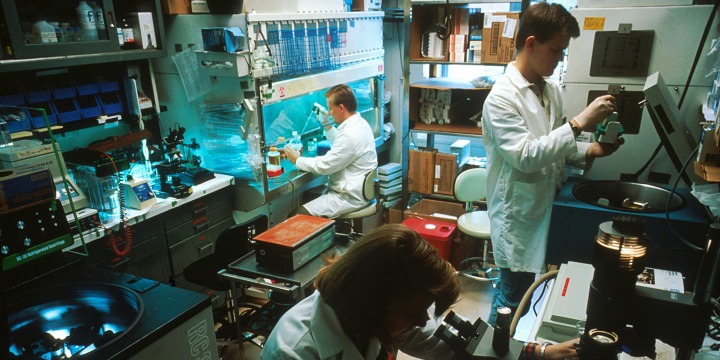‘New Hope’ in Fight Against Tay-Sachs Disease
 by Ira Stoll
by Ira Stoll

Scientists at work in laboratory. Photo: Public domain via Wikicommons.
Researchers at the University of Massachusetts Medical School are touting a possible breakthrough in the fight against Tay-Sachs disease, a genetic disease that killed 50 or 60 Jewish children a year in the US and Canada until widespread screening reduced its incidence.
The genetic testing and pre-conception screening focused on populations such as Ashkenazi Jews that are known carriers. Even so, some babies are born with the disease.
This month, UMass and a gene therapy company, Axovant Gene Therapies, announced that they had treated two such patients by administering a gene therapy.
The chief research and development officer at Axovant, Dr. Gavin Corcoran, called the clinical results “exciting” and said they “suggest an opportunity for gene replacement therapy to improve outcomes for children with this devastating condition.”
The dean of the UMass Medical School, Dr. Terence Flotte, who is a professor of pediatrics, said, “This innovative delivery could overcome one of the primary challenges for developing treatments for Tay-Sachs, Sandhoff and many other severe pediatric genetic disorders, providing much needed hope for these families.”
The medical school is based in the central Massachusetts city of Worcester.
Kevin Romer, president of the Matthew Forbes Romer Foundation and a past president of the National Tay-Sachs and Allied Diseases Association, told The Algemeiner, “This is important continued progress with our collective efforts to make a treatment available.” The foundation is named for Romer’s son Matthew, who died of Tay-Sachs in 1996.
The development has until now received little attention in the Jewish community. It did attract press coverage from WBUR, a Boston public radio station, whose reporter, Carey Goldberg, cautioned, “It’s a very early report, from just two patients, only a few months after treatment.” But she also wrote that it “could be landmark news about a terrible genetic disease. … One [patient], treated at just seven months, has appeared to stabilize instead of following the typical quick slide toward death by age four.”
The therapy involves injecting an engineered virus into the thalamus, which is part of the brain. The technique was initially tested by animal doctors on a flock of sheep at Auburn University in Alabama.
The UMass medical school magazine headlined the news, “New hope for Tay-Sachs disease,” reporting, “the death sentence of Tay-Sachs disease is being challenged by a new gene therapy.”
The magazine quoted Rick Karl, president of the Cure Tay-Sachs Foundation, as saying, “We have been waiting for this moment for a long time,” calling it “the most promising treatment we have seen so far.”
It also quoted a researcher who worked on the project, Miguel Sena-Esteves, as saying, “We all realize there is still a long way to go, but taking this new therapy to patients is an important step forward.”
Approximately one in 27 adult Ashkenazi Jews are carriers of the genetic disease, according to the article in the UMass Medical School magazine.
 US Stops UN From Recognizing a Palestinian State Through Membership
US Stops UN From Recognizing a Palestinian State Through Membership Jordan Reaffirms Commitment to Peace With Israel After Iran Attack, Says Ending Treaty Would Hurt Palestinians
Jordan Reaffirms Commitment to Peace With Israel After Iran Attack, Says Ending Treaty Would Hurt Palestinians ‘Crisis at Columbia’: Elite University Spirals Into Chaos Against Backdrop of School President’s DC Testimony
‘Crisis at Columbia’: Elite University Spirals Into Chaos Against Backdrop of School President’s DC Testimony ‘A Time for Vigilance’: FBI Director Says Agency on Alert for Threats Against Jewish Community During Passover
‘A Time for Vigilance’: FBI Director Says Agency on Alert for Threats Against Jewish Community During Passover New Haggadah Released for Israeli Soldiers in Gaza Ahead of Passover
New Haggadah Released for Israeli Soldiers in Gaza Ahead of Passover ADL Data Reveals Alarming Campus Antisemitism, Despite Strong Jewish Life
ADL Data Reveals Alarming Campus Antisemitism, Despite Strong Jewish Life New Hospital Approved for Construction in Southern Israel Amid Gaza War
New Hospital Approved for Construction in Southern Israel Amid Gaza War UN Security Council to Vote Thursday on Palestinian UN Membership
UN Security Council to Vote Thursday on Palestinian UN Membership New Play Opening in NY Recounts Verbatim Testimonies From Oct. 7 Survivors, Families of Victims
New Play Opening in NY Recounts Verbatim Testimonies From Oct. 7 Survivors, Families of Victims



 ‘A Time for Vigilance’: FBI Director Says Agency on Alert for Threats Against Jewish Community During Passover
‘A Time for Vigilance’: FBI Director Says Agency on Alert for Threats Against Jewish Community During Passover Anti-Israel Activists Protest Outside US, Israeli Pavilions at Venice Biennale, Accuse Jewish State of Genocide
Anti-Israel Activists Protest Outside US, Israeli Pavilions at Venice Biennale, Accuse Jewish State of Genocide ‘Crisis at Columbia’: Elite University Spirals Into Chaos Against Backdrop of School President’s DC Testimony
‘Crisis at Columbia’: Elite University Spirals Into Chaos Against Backdrop of School President’s DC Testimony Gaza Terrorist Spokesperson Reveals How Media Falls for Terror Group’s Lies
Gaza Terrorist Spokesperson Reveals How Media Falls for Terror Group’s Lies Jordan Reaffirms Commitment to Peace With Israel After Iran Attack, Says Ending Treaty Would Hurt Palestinians
Jordan Reaffirms Commitment to Peace With Israel After Iran Attack, Says Ending Treaty Would Hurt Palestinians